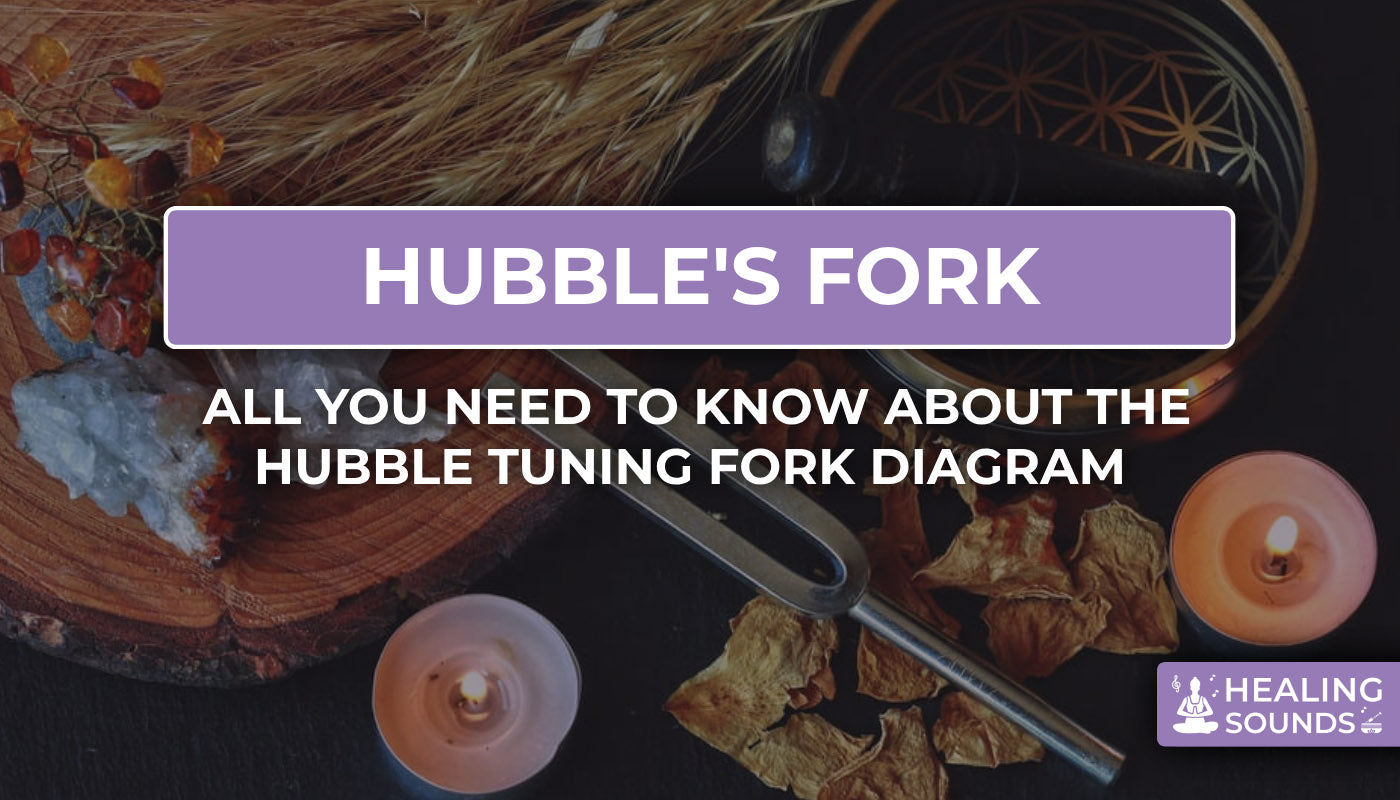Embark on a journey from the vast expanse of the cosmos to the subtle vibrations within your own being. While seemingly worlds apart, the Hubble Tuning Fork Diagram used in astronomy and the tuning forks for healing used in sound therapy share a fascinating conceptual link: the power of structure and frequency. At Healing Sounds, we explore how understanding cosmic patterns, like those mapped by the Hubble sequence, can deepen our appreciation for the resonant power of sound healing to bring harmony and balance.
This article delves into the Hubble Tuning Fork Diagram, explaining its significance in galaxy classification, and draws intriguing parallels to the way specific frequencies used in sound healing can organize and harmonize our energetic systems. Discover how the universe's grand design echoes in the vibrations that can support your well-being.

What is the Hubble Tuning Fork Diagram?
Developed by astronomer Edwin Hubble in 1926, the Hubble Tuning Fork Diagram is a classification system used to organize galaxies based on their visual appearance, or morphology. It's a foundational concept in astronomy, often referred to as the Hubble sequence. It doesn't represent an evolutionary path for galaxies, but rather a way to categorize them effectively.
The diagram visually resembles a tuning fork, hence its name. It branches into two main types of galaxies originating from a common group:
- Elliptical Galaxies (E): These are smooth, featureless galaxies ranging from nearly spherical (E0) to highly elongated (E7). They are placed at the "handle" of the tuning fork.
-
Spiral Galaxies: These form the two prongs of the fork.
- Normal Spirals (S): Characterized by a central bulge and spiral arms winding outwards. They are classified from Sa (tightly wound arms, large bulge) to Sc (loosely wound arms, small bulge).
- Barred Spirals (SB): Similar to normal spirals, but featuring a distinct central bar structure from which the arms emerge. They are also classified from SBa to SBc based on arm tightness and bulge size.
- Lenticular Galaxies (S0): These are intermediate galaxies, possessing a central bulge and a disk like spirals, but lacking distinct spiral arms. They sit at the junction where the handle meets the prongs.
This system provides astronomers with a coherent framework for studying the vast diversity of galaxies and understanding their properties based on their form – a method of bringing order to cosmic complexity.
Cosmic Resonance: Connecting Galaxies and Sound Frequencies
While the Hubble Tuning Fork Diagram organizes galaxies by shape, sound healing uses specific frequencies to organize and harmonize energy within the body. The diagram's structure provides a powerful metaphor for how distinct vibrational patterns can create different effects, whether on a cosmic scale or within our personal energy fields.
Just as galaxies possess unique structures—ellipticals containing older stars, spirals hosting active star formation—different sound frequencies carry distinct energetic signatures. These frequencies can resonate with our chakras, tissues, and emotional states, promoting balance and well-being.

432 Hz Tuning Fork with Resonance Box
49.90 59.90
Experience the universally recognized frequency of harmony (432 Hz). This fork, amplified by its resonance box, encourages deep relaxation and aligns your energy, mirroring the balanced structures seen in cosmic patterns.
Explore 432 Hz HarmonyTuning Forks for Healing: Our Body's Resonance Map
Sound therapy utilizes tools like tuning forks to introduce specific frequencies to the body's energy field, much like the Hubble diagram maps galaxy types. These vibrations can help clear blockages, reduce stress, and restore a natural state of equilibrium. The concept of resonance is key – applying the right frequency encourages the body to vibrate in harmony.

Weighted vs. Unweighted Forks: Different Vibrational Signatures
Similar to the distinct categories in the Hubble sequence, tuning forks come in different types for varied effects:
- Weighted Tuning Forks: These have weights at the ends of the prongs. They produce stronger vibrations felt more physically, ideal for applying directly to the body to release muscle tension, soothe nerves, and promote grounding. Think of them as the stable, grounding energy of elliptical galaxies.
- Unweighted Tuning Forks: These produce clearer, audible tones that resonate in the space around the body. They are excellent for clearing energetic fields, balancing chakras, and enhancing mental clarity, akin to the expansive energy of spiral galaxies.
Mapping Frequencies: Chakras, Planets, and Beyond
Sound healing often employs specific frequency sets to target different aspects of well-being:
- Chakra Frequencies: Each energy center is associated with a specific frequency believed to restore its balance (e.g., Root Chakra for grounding, Third Eye for intuition).
- Planetary Frequencies: Based on the orbital frequencies of planets, these forks connect us to celestial energies (e.g., Mars for action, Venus for love).
- Solfeggio Frequencies: An ancient scale known for its purported spiritual and healing benefits (e.g., 528 Hz for transformation, 396 Hz for liberating fear).
Key Frequency Applications in Sound Healing:
- Grounding & Stability: Low frequencies like Otto Tuners (e.g., 128 Hz) or Earth frequencies.
- Emotional Release & Harmony: Mid-range frequencies like Solfeggio (e.g., 528 Hz, 639 Hz) or 432 Hz.
- Mental Clarity & Spiritual Connection: Higher frequencies like 4096 Hz Crystal Tuners or Angel Tuners.
Discover Tools for Vibrational Alignment

Professional Otto Tuners Weighted 4 Tuning Forks Set
99.90
129.90
Deepen grounding and relieve physical tension with these weighted forks, resonating with the stable energy evoked by elliptical structures. Learn more ➔
Elevate your frequency with this high-vibration crystal tuner, perfect for energy clearing and connecting with higher consciousness. Learn more ➔

512 Hz Medical Tuning Fork Instrument
39.90
79.90
A standard frequency used in hearing tests and sound therapy, the 512 Hz fork promotes balance and harmonization, useful in various applications. Learn more ➔
Limitations and Modern Understanding
It's important to remember the original intent of the Hubble Tuning Fork Diagram. While Hubble initially speculated it might show an evolutionary sequence (ellipticals evolving into spirals), modern astronomy understands that galaxy evolution is far more complex, involving mergers and environmental factors. The diagram remains a valuable tool for galaxy classification based on morphology, not a strict evolutionary path. For more details on modern galaxy understanding, you can explore resources like NASA's Hubble insights on galaxies.
Similarly, while the analogy to sound healing is evocative, it's metaphorical. Sound therapy works through principles of resonance and nervous system regulation, not direct cosmic alignment. However, contemplating these cosmic structures can inspire a deeper connection to the universal principles of order, resonance, and harmony that underpin sound healing practices.
Conclusion: Resonating with the Universe Within
The Hubble Tuning Fork Diagram offers a beautiful way to visualize order within the vastness of the cosmos through galaxy classification. While its astronomical purpose is specific, its structure provides a compelling metaphor for how tuning forks for healing utilize distinct frequencies to bring order and harmony to our inner universe.
By understanding the principles of resonance—whether observing the grand spiral arms of a galaxy or feeling the subtle vibrations of a 432 Hz tuning fork—we tap into a universal language. At Healing Sounds, we provide high-quality tuning forks, crafted from durable materials and precisely tuned, to help you explore this language. Discover the frequencies that resonate with you and embark on your own journey of sound-based wellness and cosmic connection.
Frequently Asked Questions about Hubble's Tuning Fork Diagram
Hubble's tuning fork diagram is a galaxy classification scheme developed by Edwin Hubble. It organizes galaxies based on their visual shape (morphology) into main categories: elliptical galaxies (handle of the fork), spiral galaxies (two prongs - normal and barred), and lenticular galaxies (at the junction). It's a visual tool for categorizing the diversity of galaxy forms.
On platforms like Quizlet, Hubble's tuning fork diagram is primarily used as an educational tool to help students learn and memorize the different types of galaxies (elliptical, spiral, barred spiral, lenticular) and how they are visually organized according to the Hubble sequence. It aids in understanding the basics of galaxy classification in astronomy.
Originally, Hubble speculated that the diagram might represent an evolutionary sequence, perhaps with ellipticals evolving into spirals. However, modern astronomy does not support this interpretation. The Hubble Tuning Fork Diagram is now understood primarily as a morphological classification system, not a direct map of galaxy evolution. Galaxy evolution is known to be much more complex, involving mergers, interactions, and environmental influences.
The Hubble diagram (often meaning the Hubble Tuning Fork Diagram or Hubble Sequence) visually shows a classification of galaxies based on their shape. It groups galaxies into ellipticals (smooth, featureless), spirals (with arms, subdivided into normal and barred), and lenticulars (disk-like but without arms), arranging them in a tuning fork shape. It primarily illustrates the morphological diversity of galaxies.
Note: The term "Hubble diagram" can also refer to a plot showing the relationship between a galaxy's distance and its recessional velocity, which supports the expansion of the universe. However, in the context of the "tuning fork," it refers to the classification scheme.
The Hubble sequence is another name for the Hubble Tuning Fork Diagram. It is Edwin Hubble's system for classifying galaxies based on their visual appearance (morphology). The sequence arranges galaxies into categories like elliptical (E0-E7), lenticular (S0), normal spiral (Sa-Sc), and barred spiral (SBa-SBc), reflecting variations in bulge size, arm tightness, and the presence of a central bar.



